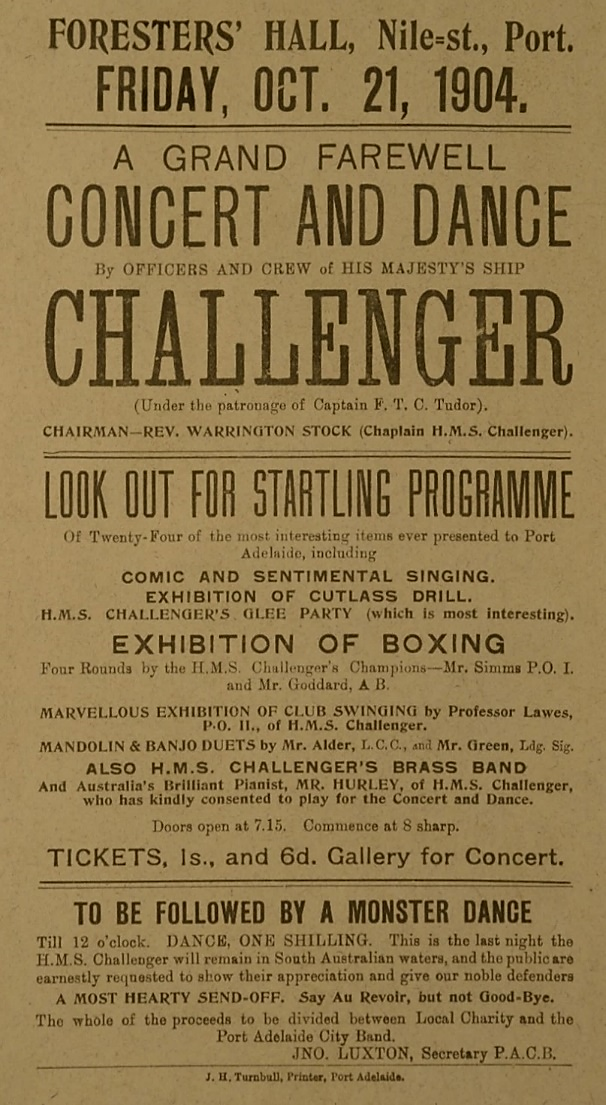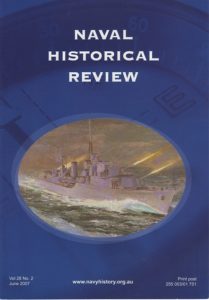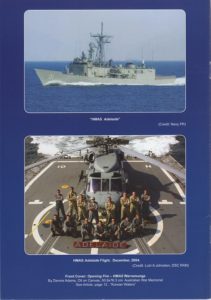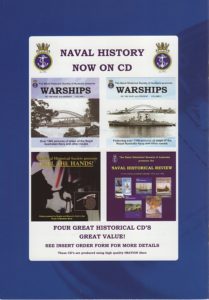From 1806 to 1981 the Royal Navy had eight ships named Challenger. Two had Australian connections. One was built in 1858 and commissioned to the Australia Station in May 1866. The other was completed and commissioned to the Australia Station in May 1904.
The Australia Station was set up as a separate command centre in 1859. In the early 1850s relations between Britain and Russia were bad and with reports of increased Russian naval activity in the Pacific plus rich strikes of gold in NSW and Victoria made it politically necessary for the British government to have a stronger naval presence to protect its Australian colonies.
On 25 March 1859 Captain William Loring of HMS Iris was authorised to ‘hoist a (commodore’s) Blue Pennant and to assume command as Senior Officer of Her Majesty’s Ships on the Australian Station independently of the Commander in Chief in India’.

HMS Challenger was commissioned by the Royal Navy on 13 February 1858. It was a spar-deck wooden screw corvette and one of three of the same class, the others being Clio and Racoon. It was well armed with eighteen 64 pdr guns, sixteen on slides on the main deck and two pivot-mounted as chase-guns, one on the forecastle, the other aft.
As part of the North America and West Indies Station HMS Challenger occupied the port of Veracruz, Mexico in 1862, following the non-payment of indemnities to people injured in a series of revolutions. It was then placed on the Australia Station in May 1866 and relieved HMS Curacoa as the Station flagship. She wore the broad pennant of Commodore Rochfort Maguire and under the command of Captain Brownrigg she made the first of several visits to New Zealand in September 1866.

Commodore Maguire died in 1867 and Commodore Rowley Lambert CB, RN assumed command as the senior officer of the Australia Station.
One of the highlights of Challenger’sterm as flagship was the first Royal Visit to Australia in 1867-1868. HRH Prince Alfred, the Duke of Edinburgh, toured some of the principal ports of Australia and New Zealand in HMS Galatea accompanied by HMS Challenger.
In July 1870 Challenger made her final visit to New Zealand and later that year she sailed for home, being relieved as station flagship by HMS Clio.
On HMS Challengers return to England she was lent to the “Royal Society of London for Improving Natural Knowledge” to undertake what was to become the most important oceanographic expedition of the era. The 3.5 year trip around the globe aimed to ascertain the sea floor’s physical and chemical characteristics and discover just how far into the ocean’s depths life exists. The trip was called “Challenger Expedition” after the ship.
The ship was refitted to make it suitable for a scientific expedition. Fourteen of the ship’s eighteen guns were removed to make space for on-board laboratories, workrooms, extra cabins, storage areas and a special dredging platform. Challenger was loaded with specimen jars, alcohol for preservation of samples, microscopes and chemical apparatus, trawls and dredges, thermometers and water sampling bottles, sounding leads and devices to collect sediment from the seabed and great lengths of rope – 291 km of Italian hemp – used to suspend the equipment into the ocean depths.
Under the command of Captain George Nares the Challenger carried a complement of 243 officers, scientists and crew when she departed England in December 1872 on her 129,640 km journey. Between December 1872 and May 1876, the ship sailed both the North and South Atlantic Oceans as well as vast swathes of the Pacific, even venturing below the Antarctic Circle. During the 3.5 years the ship made over 500 stops to scoop samples from the seabed with weighted nets, study marine life, gauge ocean depths and measure water temperatures.
The expedition was also the first to record the astonishing scale of the Mariana Trench, the Pacific chasm that stretches far deeper than Mount Everest is tall. The trench’s lowest point – 10,929m – was called Challenger Deep. (Researchers have since found that an even deeper point exists nearby, nearly 11,265m deep).
By the end of the voyage, the “Challenger Expedition” scientists had assembled a huge collection of deep-sea life proving the abundance and variety of marine life throughout the oceans. The expedition’s temperature readings and sea depth measurements created a valuable historical benchmark. The effect of climate change on water temperatures is just one area in which the voyage’s findings have proved invaluable.
On completion of her global voyage Challenger was commissioned as a His Majesty’s Coastguard and Royal Naval Reserve training ship at the Harwich Dockyard in July 1876. In 1878, Challenger went through an overhaul and was found suitable to convert. This conversion did not occur and she remained in reserve until 1883, when instead she was converted into a receiving hulk in the River Medway, where she remained until she was sold in 1921 and broken up for her copper bottom that same year.
HMS Challenger (Commissioned 1904)
This was the sixth ship to carry the name HMS Challenger. It was commissioned on 4 May 1904 and assigned to the Australia Station 1904-12. Under the command of Captain F L Tudor. She sailed for the Australia Station calling at Colombo, Batavia, Fremantle, Albany, Melbourne and finally arriving in Sydney on 23 July 1904.
HMS Challenger was one of two second class protected cruisers, the other being Encounter, which came to the Australia Station a couple of years later than Challenger and was subsequently transferred to the Royal Australian Navy.
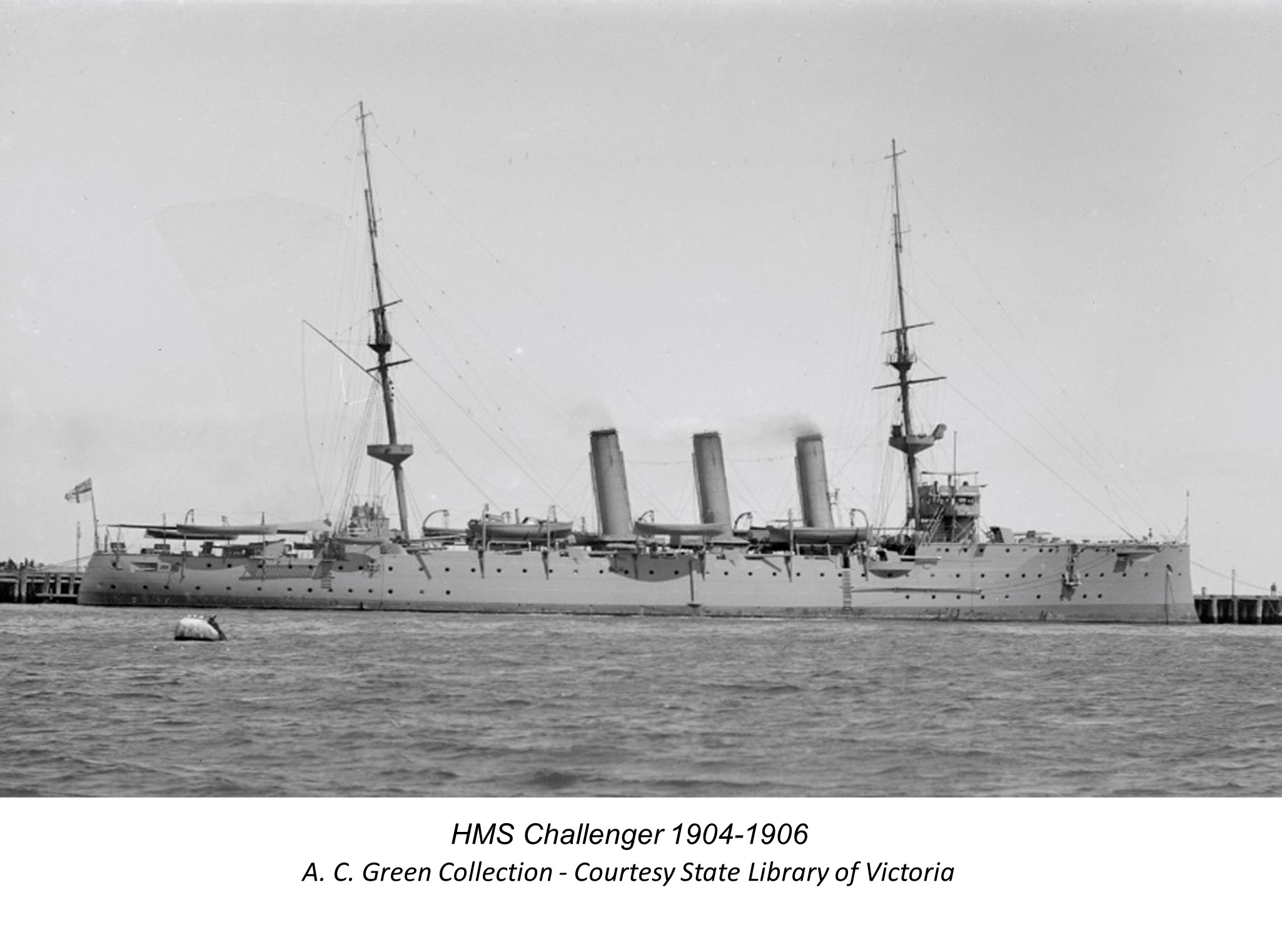
Challenger was well armed having eleven 6 in guns, eight 12pdr and six 3pdr quick firing guns, several machine guns, and two 18 in submerged torpedo tubes. The Australians were impressed with the appearance of the newest Royal Navy ship when she arrived in Fremantle. Painted a sombre grey all over with three funnels and two masts – a real man-o’-war ship was now allocated to Australia.
Our history of HMS Challenger’s time on the Australia Station has been greatly enhanced by a Journal that was received by the Navy Historical Society. Due to its cultural significance, it was presented to the Australian War Memorial.
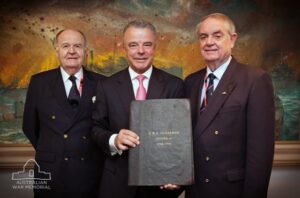
The Journal consists of newspaper clippings from the different state newspapers as Challenger moved around Australia and New Zealand. These clippings help to provide a cultural history of the time and especially the importance of this new warship to the Australian and New Zealand people.
Media Reporting on HMS Challenger
Naval and Mil. Record 19 May 1904
“The reorganisation of the Australian Station is in progress. The strength of the squadron is to be improved and the Imperial spirit will be fostered by the decision to man one of the ships with Australians. The HMS Challenger will be used for this purpose.
Australians look forward to the time when crew and officers will be Australians. No fewer than 900 colonists are to be enlisted for a term of 3 to 5 years.
The Challenger will be used as a ‘recruit’ ship in terms of the naval agreement of 1903 whilst she is in the Commonwealth, and some hundreds of Australians, it is expected will receive instructions in naval seamanship on board.”
For the purpose of training colonial recruits, three training ships are maintained, Katoomba and Mildura off Australia and the Phoebe on the New Zealand coast. Recruits for the Navy are taken on by the three training vessels and while some continue to remain on them others are drafted onto the Challenger.
The following newspaper article from “The Western Australian” 6 July 1904 gives some idea of how the ship was greeted on its arrival in Australia.
“The quay in the vicinity of the HMS Challenger was thronged all day yesterday by crowds of interested sightseers.”
“For the benefit of those of the public who desire to inspect the man-o’-war, it has been decided to throw her open to-day and to-morrow between the hours of 1.30pm and 5 o’clock. During the afternoon the Challenger was crowded from stem to stern….”
The Challenger took on 30 recruits in Fremantle then sailed to Albany for refuelling and stopping at Melbourne to take on 10 more recruits before sailing to Sydney and arriving there on 23 July 1904. Recruits were to be taken from every state and from New Zealand for training on a modern warship.
The newspaper articles in the Journal show that at every port that the ship visited in Australia and New Zealand an incredible number of social and sporting activities were organized for the ship’s officers and crew. The mayor of nearly every city organised an official banquet for captain and officers and the following two newspaper advertisements give some idea of the activities organized by the local people. At most ports the ship was opened for the public to inspect and they were well attended.
Morning Herald Western Australia 21-06-06
HMS Challenger will be in Fremantle until 2 July, then sails to Singapore arriving 10 July, there until 6 August and back in Sydney by 10 August.
The Daily Telegraph (Sydney, NSW : 1883 – 1930) Fri 6 Jul 1906 Page 4
H.M.S. CHALLENGER, FOR SINGAPORE.
A telegram from Fremantle yesterday stated that HMS Challenger sailed at 9 a.m. en route to Singapore. The Challenger is proceeding to the East for a relief crew, which Is being sent out from England by one of the big cruisers.
These were the last two newspaper cuttings in the Journal. The rest of Challengers time on the Australian Station was not recorded in the Journal.
The Sydney Mail, Wednesday, December 7, 1904.
HMS Challenger in Dock
It is eight months since the Challenger was last in dry dock, and in since then she has steamed well over 16,000 miles. The periodical examination of the bottom of an unsheathed ship should be carried out once in six months. …… An unsheathed ship (no copper sheath over the iron plating) has not this protection and the iron plating which forms her bottom is only kept from actual contact with the water by a thin coating of a peculiar kind of paint, known as “anti-fouling composition”. As the composition wears off, the plating becomes exposed and rust occurs. Hence the need to dry dock and repaint.
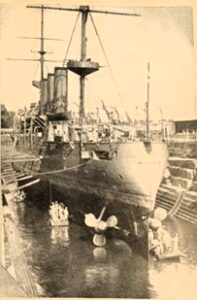
One of the big events that the Challenger participated in after this time was in 1911 under Captain G Gaunt she visited Valparaiso Chile for that country’s centennial celebrations. HMS Challenger remained at anchor for two weeks in Valparaíso and then returned.
The following is an extract from Mr Blakeney’s memoirs, he was a sailor on board the Challenger on this voyage:
“In 1911 I was in HMS Challenger….. as an Able Seaman on way to Valparaiso, Chile, for Centenary celebrations. After visiting most of the large island groups we called at Tahiti, Pitcairn and Easter Island. First port of call on the West Coast of South America was Callao to coal ship and then to Valparaiso where we joined up with HMS Kent from the China Station. When the celebrations were over we called at the Panama Canal (west side). The canal was still under construction. We coaled ship in 119° Fahrenheit. One chap received severe sunstroke, another became a bit funny in the head….. Back to Aussie, calling at Fiji, then Lyttleton, South Island, New Zealand and Sydney.”
In early July 1912 Challenger set sail for home, taking with her many of the ship’s company of her sister ship Encounter, which had paid off from the Royal Navy and had been transferred to the Royal Australian Navy. Sailing via Fremantle, Colombo and Suez, Challenger arrived home and paid off into reserve on 10 October 1912.
She recommissioned for service in WW 1, and in 1914 she was a unit of the Ninth Cruiser Squadron which was detached to West Africa for the Cameroons Campaign 1914-15. Won the Battle Honour: Cameroons 1914. From 1915 onwards she served in East African waters. Returned to the UK at the end of the war. In 1918 she was declared for disposal and was sold in May 1920 to Wards of Preston and broken up.


